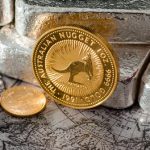By far, gold detectors are the most popular tool among amateur prospectors and treasure hunters. For all intents and purposes, gold detectors are metal detectors – but specifically constructed and calibrated for gold hunting. To explain how these tools excel at finding gold, it helps to understand the science behind basic metal detectors.
Metal detectors work by transmitting an electromagnetic field into the ground, then analyzing the return signal. The electromagnetic field transmitted by the detector induces loops of electrical current, called eddy currents, within conductive materials (i.e. metals). Eddy currents generate their own electromagnetic field, which the detector receives and analyzes.
Gold detectors take this process a step further by measuring inductance and conductivity. Basically, inductance refers to the amount of eddy currents produced in the target. Conductivity refers to how easily those currents flow. By measuring the size of the eddy currents and how fast they are traveling, gold detectors can calculate the “time constant” of a target.
Time constants can vary considerably between targets. For example, bits of aluminum foil have very short time constants, gold coins and rings have longer time constants, and scraps of steel, iron, and other ferrous metals have even longer time constants. Gold detectors can be calibrated to specifically search for targets that fall within that “middle” range. Unfortunately, it’s not a foolproof method. The size, shape, and distance of a target (along with other environmental variables) affect the accuracy of the detector’s time constant calculation. To compensate, gold detectors can be re-calibrated on-the-fly to search for a broader or narrower range of time constants.











